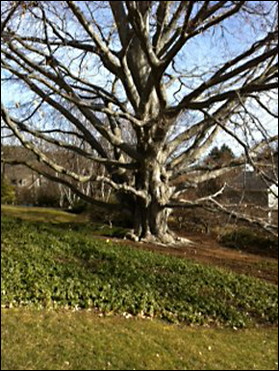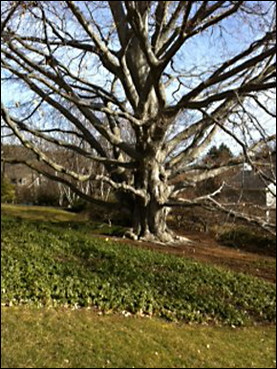 |
1. Be conservative. Don’t change the habitat in which the tree has been doing well. No new plantings underneath. No new treatments or chemicals. Don’t dig up the soil over the root run. Roots are just a very few inches below the top of the soil, or often right in the top of the soil under mulched leaves.
2. Don’t change the root environment under a happy tree. Roots spread 2 or 3 times as wide as the drip line and they require mychorrizhea, (which are microbes, good fungi, and other microscopic organisms) to thrive. Grass inhibits and competes with these.
That’s why a wide bed of mulch enhances health. Fallen leaves left in place will self compost.
To improve the design, make a perfect circle or an aesthetically planned shape under the tree. Add a bench or a statue.
3. Don’t ever add any fill, even good loam, deeper than 3 inches over the roots. Six inches over a beech or sugar maple will kill them.
4. A new sprinkler under the tree will disrupt the existing metabolism and may rot the roots. Beyond the edge of the leaf canopy, new roots will eventually find the new water and the tree will gradually adjust.
During extended droughts, soak the roots really deeply. It may take some days to cover the whole root run of a large tree. If a soaking is adequate, it is usually necessary only once a month.
5. Don’t push fertilizer and force an old tree to grow faster. One wants to keep it alive, not make it bigger. Ideally use organic. Standard advice is no more than every 3-5 years, and then sparingly. Top dressing is just as effective as punching holes. And be wary of herbicides over the root run, especially beech and locust.
6. Treat only problems that are important and threaten the trees’ health. All have a few bugs, a little fungus, branches that break, and such. These don’t necessarily have to be completely cured, just kept under control.
7. Large trees can lose a small portion of their root run for necessary construction. However, large major roots should be excavated, underneath, not cut, and pipes can be pushed underneath them.
8. Unfortunately, hurricanes and high winds are one of the major killers of old trees. Preventative pruning can help. Structural pruning for strength and balance is important BUT don’t overprune.
However, in windy places, like Hawaii, trees are pruned to have "windows" in them. These are generous open spaces where the wind can blow through.
9. The upper bark shouldn’t be suddenly exposed to sunlight. Certain old trees, particularly beech, oak and sugar maple die back and can be killed by sunburn on the high branches and trunk. Pruning should remove dead or dangerous branches, keep the tree well balanced, and the leaves thinned just enough so high winds can blow right through.
10. Cables are also often needed to help balance the tree and keep heavy branches from splitting off. Decay begins at the crotches, so cables should be as high as possible to help the most.
11. In Europe, pollarded trees (whose branches are pruned back each year or two) seem to live a long time. Currently there is re-thinking about whether and how to reduce large old trees. This is a continuing debate, but reducing the top growth to enhance stability is a good thing.
Old Trees Are Like Old People
Old trees are like old people. They are fragile but with gentle care, can survive a while more. Some people are lucky and inherit old trees, perhaps not famous but cherished none the less. The challenge is to make caring for them cost effective. And keeping them safe.
Credit: www.mothersgarden.net




























